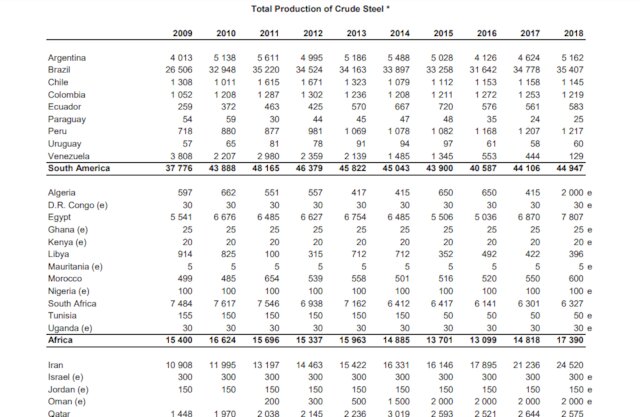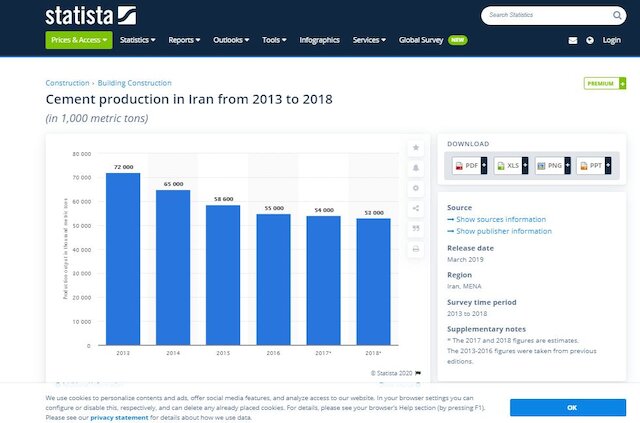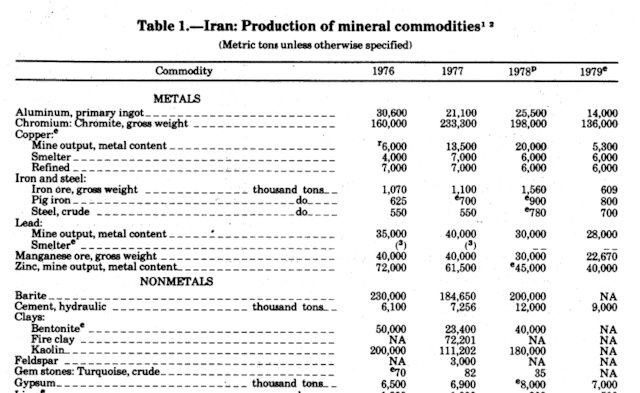“If the Islamic Revolution hadn’t taken place, Iran would have been much more advanced, at least in terms of industry.” This is a statement, which the world’s mainstream media outlets insist on. However, aside from the media’s politically charged viewpoint regarding Iran and subjects related to it, do the statistics and studies show Iran to be a desperate, stagnant country in industrial fields after the Islamic Revolution? To find the answer to this question, the following text is a documented report about the situation of industry in Iran before and after the Islamic Revolution. It is worth noting that the data used in this report comes from the research work of international organizations.
Steel
One of the main pillars for economic growth and development is the creation of sustainable development structures, of which mining and the mining industry—particularly steel—are among the most important. The production and consumption of steel are considered to be one of the main indicators of a country’s development. In addition to its prominent role in the development of countries, the steel industry’s considerable impact on increasing the level of knowledge, job creation, research, education, and trade is undeniable. It should be noted that the steel industry is known as a key industry in the world. After oil and gas, it is the second most traded commodity in the world. According to the statistics provided by the World Steel Association, there are only 70 countries active in the steel industry. On the one hand, countries lagging behind in the steel industry become importing countries, and on the other hand, they are deprived of the fundamental role the growth of such industries plays in each country’s economic system.
During the Pahlavi regimes, Iran chiefly found itself wrestling with an import-oriented attitude in the areas of industry and production. In Pahlavi Iran, this attitude was so dominant that "heavy inputs of foreign capital, personnel, and imports were favored by official policies."[1] The Revolution in 1979 completely changed Iran’s political spirit and mindset, which inevitably led to a series of essential, methodological changes in the economic and industrial sectors, favoring self-sufficiency and independence over other options. This same outlook has made Iran one of the top 10 steel producing countries according to a report published in January 2019 by the Economic Times.[2] It should be mentioned that Iran's post-revolutionary spirit, favoring self-reliance and self-sufficiency over dependence in different industry sectors, resulted in a production of 25 million tons of steel in this country in 2018. This is 19 times more than the steel produced in 1978, which was at the end of the Pahlavi period.
In 1977, there were 47 large factories producing essential metals, which had a total of 6,777 employees. In 2015, this number increased to 677 factories, and the number of employees in these factories grew to 130,620. In 1977, there were 477 factories active in building metallic machinery, tools, equipment and products, and they had employed a workforce of 57,724 people. In 2015, the number of factories and workers soared to 2,562 and 127,004 respectively.
Cement
In recent decades, Iran has moved forward rapidly in cement production. It has seen a growth in this fundamental industry, which has been a key to many product development projects. For example, Iran has exported 48 thousand tons of cement to the United Arab Emirates in just 6 months.[3] Other countries, such as Russia, Uzbekistan, Afghanistan, and Kazakhstan, are also among the main destinations for Iran’s cement exports. Iran is rich in mineral reserves to such an extent that cement can be manufactured almost anywhere in the country. Thus Iran has been able to reduce a major part of costs related to transporting raw material to the factory and keep this industry at maximum profitability. In addition, Iran has been able to become self-sufficient to a great extent regarding the technology for the extraction and production of cement. Despite the United States sanctions, Iran produced more than 50 million tons of cement in 2018, which shows a 25-fold jump compared to the production of cement in Iran before the Revolution. (In his book “A Regional Guide to Iran,” Harvey Henry Smith estimated Iran’s cement production to be around 2 million tons in 1968.)[4] Statist reports that Iran was 11th in the world in terms of cement production in 2018.[5]
Aluminum
The industry for the extraction and production of aluminum is another industry in the Islamic Republic of Iran where considerable progress has been made. This industry has a significant advantage over other industries in the global markets. Due to its strength, low weight, high recyclability, and compliance with the principles of environmental protection, aluminum is a highly strategic product in the modern era. According to the United States Geological Survey (USGS), Iran produced more than 355 thousand tons of aluminum in 2016. This amount earned Iran the 21st place in the world for aluminum production. This amount of production, compared to 1977 when Iran produced approximately 21 thousand tons of aluminum, shows a 17-fold growth. According to a report from Aluminum International Today (AIT), “Iran seeks to increase annual output of aluminum to more than 800,000 tons by March 2022, and more than $11 billion will be attracted in investment to bring that figure to 1.5 million tons by 2025."[6]

Copper
Copper was one of the first metals to be discovered by human beings. Interestingly, it still appears today among the top of the list in terms of usage and function. Areas where this metal is used include: civil engineering projects, power generation, manufacturing of electronics, heating and cooling systems, the automobile industry, etc. Today, Iran ranks 13th in the world in terms of copper production and its share in the global copper industry.[7] Iran's copper industry during the time of the Pahlavi regime in 1977, was ranked last among Asian copper producers, lower than countries such as India, Japan and Turkey. But post-revolutionary Iran surpasses most Asian countries such as Turkey and India in terms of copper production. The noteworthy point about the Iranian copper industry is its growth rate in recent years. According to a report published by Mining.com, Iran’s copper output will increase even more in the coming years, averaging yearly growth rates of 13% through 2020, compared to just 2.1% during the past five years. Copper production is expected to top 500,000 tonnes.[8]
Electricity
Before the Revolution, there were only three million electricity consumers in Iran. But today, 98 percent of the country’s population has access to electricity. This means nearly 80 million people. The unique point about the Iranian electric power industry is that the price of electricity in Iran is very low compared to the rest of the world.[9] This has made it possible for industries to produce products at lower prices. Countries such as Armenia, Afghanistan, Azerbaijan, Turkey, Turkmenistan, Pakistan, and Iraq are the target export markets for Iranian electricity. Iran currently ranks 16th in the world due to its producing more than 312,000 GWh of electricity annually.[10] The following chart shows the amount of electricity produced in Iran before and after the Islamic Revolution.
Conclusion
Despite the unprecedented economic sanctions imposed by the domineering powers on Iran in recent decades, and especially in recent years, the country has made dramatic advances in industry since the establishment of the Islamic Revolution. Contrary to the approach of the Pahlavi regime - which was highly dependent on imports and oil revenues to supply the country's needs, especially from Western countries and the United States - Iran has sought to stimulate domestic production and strengthen its industrial power after the Islamic Revolution. This approach has led to huge growth (tens of times) in Iranian key industries and placed it among the top 10 countries in the world. Therefore, economic sanctions against Iran have caused this country to realize that the correct, effective way to deal with these sanctions and to maintain its political and economic independence from the domineering powers is to strengthen its industrial power within the country to become a supplier and exporter instead of an importer and consumer.
[1] Keddie, Nikki R., and Yann Richard. Modern Iran Roots and Results of Revolution. Yale Univ. Press, 2006.
[2] https://economictimes.indiatimes.com/industry/indl-goods/svs/steel/india-replaces-japan-as-second-top-steel-producer-worldsteel/articleshow/67721395.cms?from=mdr
[3] https://www.globalcement.com/news/item/10168-uae-imports-48-000t-of-cement-from-iran-s-qeshm-free-trade-zone-in-six-months
[4] Smith, Harvey H. Area Handbook for Iran. Vol. 550, Issue 68, U.S. Gov. Print. Off., 1971.
[5] https://www.statista.com/statistics/267364/world-cement-production-by-country/
[6] https://aluminiumtoday.com/news/iran-opening-first-phase-of-1-billion-aluminium-smelter
[7] https://www.indexmundi.com/minerals/?product=copper&graph=production
[8] https://www.mining.com/resurgent-iran-impact-copper-zinc-prices-2020/
[9] https://www.globalpetrolprices.com/Iran/electricity_prices/
[10] https://www.theglobaleconomy.com/rankings/electricity_production_capacity/









Comments